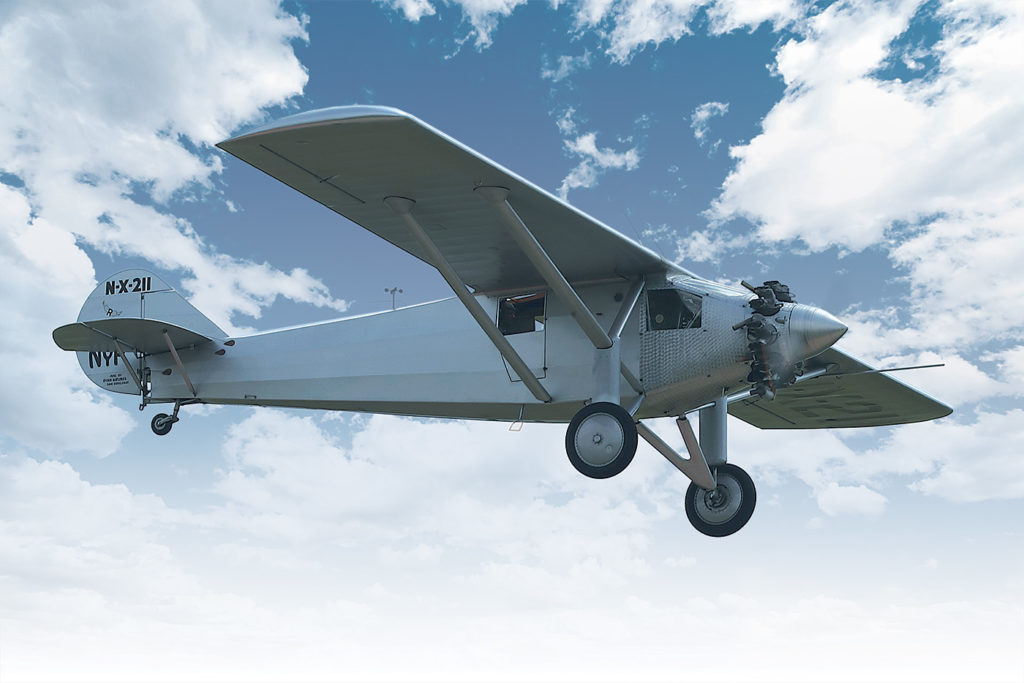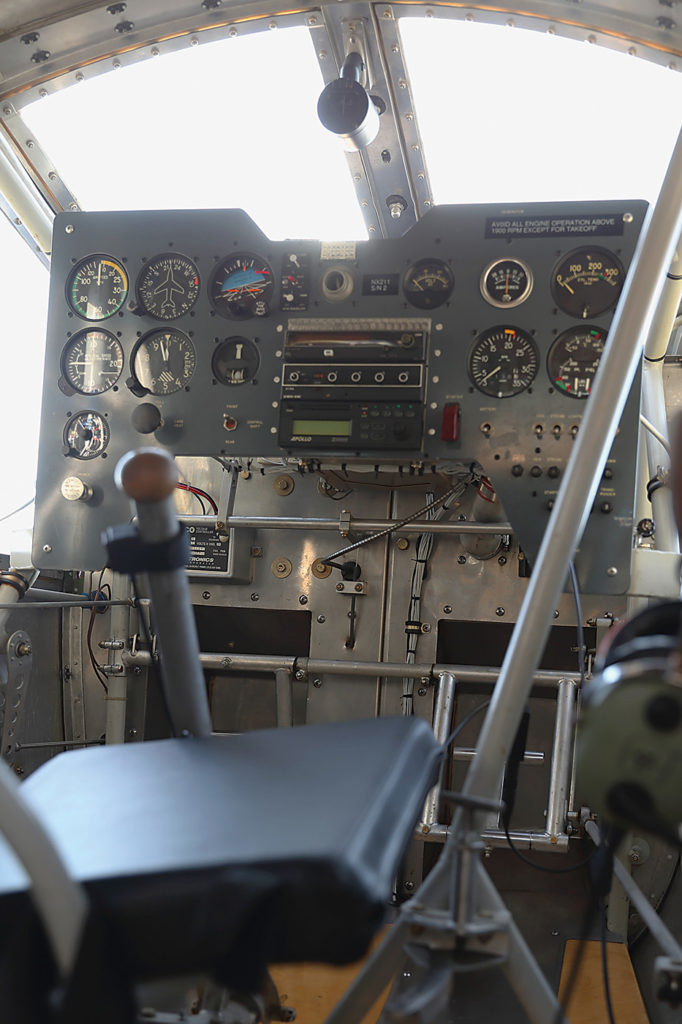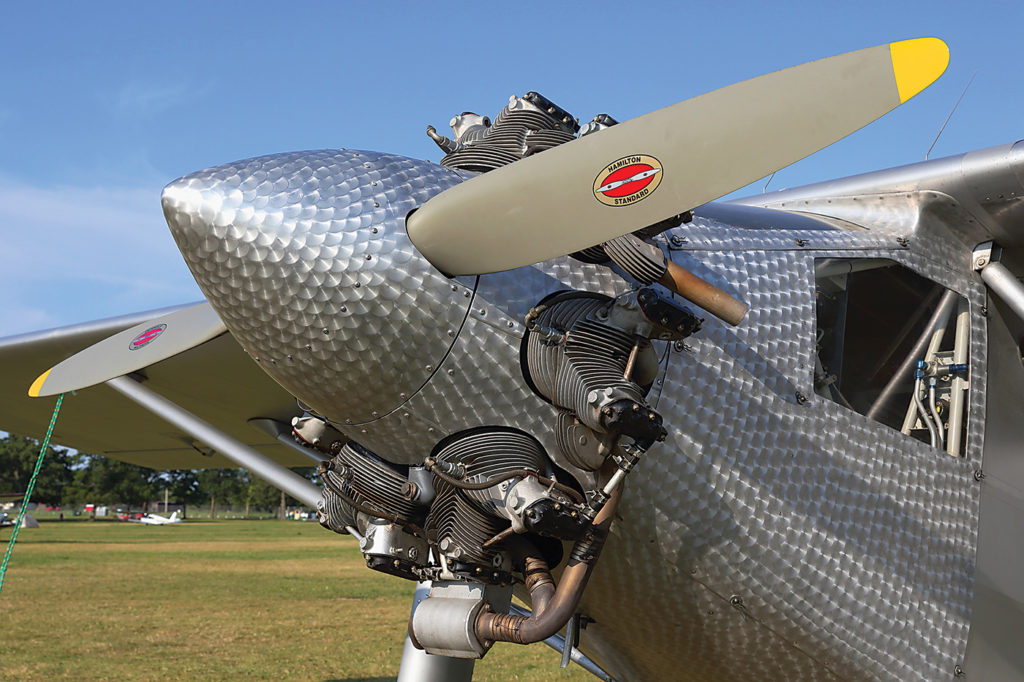Estimated reading time 12 minutes, 15 seconds.
The Orteig Prize of $25,000 was to be awarded to the first aviator(s) to fly non-stop from New York to Paris, or vice versa. The goal of inciting a transatlantic flight was to stimulate progress in aviation, and the prize was established in 1919 when a flight across the Atlantic was still a nearly inconceivable technological feat.

A number of teams vied for the prize, and their efforts sometimes proved dramatic. A team led by Frenchman Rene Fonck made an attempt in 1926 in a massive three-engine Sikorsky S-35, spectacularly crashing their overloaded airplane on takeoff. Prevailing design logic reasoned that the necessarily massive fuel load would require a similarly massive airplane, which would further need multiple engines and a large crew.
Charles Lindbergh saw things differently. He wanted a minimalist airplane. He wanted it quickly, and he wanted it on a budget. On Feb. 3, 1927, he cabled a telegram to Ryan Airlines of San Diego, Calif., asking, “Can you construct a Whirlwind engine plane capable of flying non-stop between New York and Paris stop If so please state cost and delivery date.”
He took off for Paris solo in his monoplane just over three months later. His airplane cost US$10,580.
To put the Spirit of St. Louis into context, glance at pictures of the cockpit of the Bombardier C Series airliner or a schematic of the Space Shuttle. People reliably express wonder at the technological sophistication of these modern designs.
By contrast, a photograph of the Spirit of St. Louis cockpit inevitably evokes smirks at its quaint simplicity. I contend, however, that the Spirit of St. Louis was in its day every bit as cutting-edge as our modern wonderplanes; a state-of-the-art machine that pushed the boundaries of contemporary technology.

Admittedly, those were not among my thoughts as I climbed away from Oshkosh’s Runway 27 in a highly authentic replica of the Spirit of St. Louis. Sitting amidst welded steel tubes, wood and fabric, bathed in the raucous music of its radial engine, flying the contraption to Paris hardly seemed a practical prospect.
As I was to discover in my brief acquaintance with Lindbergh’s airplane, the limits of 1927 technology demanded superlative flying skills to accomplish so ambitious a goal.
How Did I Get Here?
My modest association with the Spirit of St. Louis had its origins at the Experimental Aircraft Association’s (EAA’s) gargantuan AirVenture fly-in at Oshkosh in 2016. I had earlier noted to a friend who worked for EAA that 2017 would be the 90th anniversary of Lindbergh’s flight, and asked what they were planning to do in commemoration.
“I dunno,” was his reply. “What are you planning to do?” This served to remind me that sport aviation is a community of volunteers, and that I had just volunteered!
In the months leading up to this year’s AirVenture, I got to work with EAA’s terrific staff to help design a simple commemorative flight program to showcase Lindbergh’s accomplishments.

EAA had built two replicas. The first was constructed in 1977 to commemorate the 50th anniversary of Lindbergh’s flight. It toured extensively before being retired to a position of honour in the EAA Museum at Oshkosh, Wis.
EAA’s second replica was completed in 1991 by EAA master craftsman Bauken Nowack after a four-year construction effort. This was the airplane that would fly at AirVenture, and the good news was that I would need to complete a check-out in it first!
My instructor in the Spirit of St. Louis, replete with its historical registration NX-211, would be the EAA’s vice-president of advocacy and safety, Sean Elliott. After a brief and thorough groundschool–one which I noted was certainly better than any training that Lindbergh had received on the machine–Elliott led his students to the flight line. Sharing the flying duties was long-time EAA stalwart Rick Siegfried.
I will presume that if you’ve read this far, you know that the original Spirit of St. Louis hangs in the Smithsonian National Air and Space Museum in Washington, D.C.
Aviators are typically well acquainted with it. Learning Lindbergh’s story is a rite of passage in aviation culture. Entering a hangar to find that iconic shape parked, fuelled and ready to fly is a remarkable moment. Siegfried and I stopped at a respectful distance to soak up the sight.
The replica is built from original plans, but was necessarily modified to co-exist with our century. A Continental R-670 engine was substituted for the increasingly rare Wright Whirlwind J-5 engine, although both have similar weight and power.

The replica’s interior, however, was designed for a different mission. By removing the enormous 450-gallon (1,700-litre) fuel tank from the centre fuselage, and relocating a more modest fuel load into wing tanks, there was room for two seats in tandem. The aluminum-skinned forward fuselage ahead of the fuel tanks was replaced with windows of questionable value. Minor changes were made to the wing layout, ailerons and vertical stabilizer based upon experience from the first replica. The addition of brakes and an electrical system was also a practical necessity for modern airports.
Meeting the Spirit Aloft
If you want a soundbite summary of the Spirit’s handling qualities, I’d describe them as awful: unstable, coupled and blind. Curious about the details? Come along on a brief flight…
Ground handling, even in gusty winds, is surprisingly conventional and pleasant, owing in large measure to the small vertical stabilizer, the further implications of which I would better appreciate once airborne.
I mainly flew from the front seat. The replica may be flown either from the front seat or Lindy’s wicker back seat, but our mission at AirVenture was to deliver Charles Lindbergh himself, in the form of young actor Aaron Busse, to his admiring throng at Oshkosh’s “Le Bourget Aeroport.”
From the front seat, the thoughtful installation of windows provided virtually no additional forward field of view compared to the back seat. The glass served as a skylight with a view of the back of the engine. From either seat, practical field of view extended from about 45 degrees of either side of the nose to a bit beyond 90 degrees. Wide S-turns while taxiing were a practical necessity.
Takeoff acceleration was quite weak, not because we were hauling a transatlantic load of fuel, but because the slow-turning, ground-adjustable metal propeller was inefficient at slow speeds, providing only 1,600 static revolutions per minute (RPM).

Elevator authority was sufficient to lift the tail passing through about 45 miles per hour (72 kilometres per hour), which slightly improved the abysmal field of view. It flew off from a slightly tail-low attitude at about 70 miles per hour (112 kilometres per hour). Normal climb was at the same speed, but even at our reduced weight a 300-foot (30-metre) per-minute climb rate was its best effort.
Upon lift-off, it was immediately evident that the Spirit was statically unstable in both pitch and yaw. That got my attention! To visualize this experience, imagine riding downhill on a shopping cart. If you ride down with the cart facing forward, that’s analogous to a stable airplane; it goes where it’s pointed. Now, ride down the hill with the cart facing backwards. I’m sure you can imagine the outcome. That notional brief and eye-opening trip describes the experience of static instability.
There is a persistent rumour, which I attribute to Jimmy Stewart’s movie portrayal of Lindy, that the airplane’s instability was a deliberate attempt to keep the pilot awake. I’m no historian, but I don’t buy it. Attempting to stay alert by fighting multi-axis static instability would be akin to keeping awake by hopping interminably on a pogo stick. Instability might be tolerable for brief periods, but no sensible person would elect to subject themselves to such treatment.
In my opinion, instability was a design compromise necessary for adequate performance. Larger and necessarily draggier tail surfaces would improve stability, but at the expense of speed and range. The Spirit’s tail area–vertical and horizontal–is modest. Instability didn’t make the Spirit uncontrollable, but it was demanding of the pilot’s attention and rendered him continuously active with the stick and pedals.

Classical control harmony was effectively non-existent, with very light rudder forces, moderate elevator forces, and almost comically stiff ailerons; necessitating two hands on occasion. The original Spirit was apparently marginally worse. I clearly recall feeling bemused awe when, upon climbing from the cockpit after less than an hour and rubbing my aching shoulders, I suddenly recalled that Lindbergh flew for over 33 hours!
When I describe the Spirit as “coupled,” I’m referring to a category of charming quirks. My notes describe the aileron control response as “absurd,” owing to the huge amount of adverse yaw, which is inadvertent yawing motion induced by aileron deflection. Of course, the effect of adverse yaw seemed amplified because the Spirit was so lacking in directional stability. Likewise, strong pitch coupling was induced by power changes. In short, the Spirit kept the pilot busy at all times.
Landings were performed at 70 miles (112 kilometres) per hour, ideally employing a continuous turn to final approach or a sideslip to preserve a view of the runway. Scanning for traffic was always a concern, as the big wings utterly blocked the view into turns.
The Spirit’s trim system consisted of a lever on the left side of the cockpit which moved the trailing edge of the horizontal stabilizer. Consequently, setting full nose-up trim was a prerequisite for having sufficient elevator authority to flare. Beyond its inherent blindness, I found landing the Spirit was relatively forgiving, in part owing to the brakes and castoring tailwheel, but of course ol’ Lindy had neither.
A Dose of Humility
My role in the commemoration was simply to take off during AirVenture, perform a few passes for the crowd, and then set course for Paris, notionally 33.5 hours away. Sitting in Lindbergh’s wicker seat gets you thinking.
In the 90 years since Lindbergh’s flight, humans have learned a lot about airplanes. Even from the perspective of our newfangled technological sophistication, I marvel at the elegant simplicity of the original Ryan monoplane; a design so perfect that there was literally nothing left to remove. Even now, over 90 technology-rich years later, I’d be hard pressed to change a single thing about the Spirit of St. Louis. Further considered in the context of 1927 know-how, with limited time, and on an already stretched budget, Lindbergh’s feat is all the more impressive.

Devoid of conveniences, creature comforts or even basic stability, the Spirit of St. Louis delivered performance in proportion to the demands it made upon the solo pilot. Such was the nascent state-of-the-art in aviation.
Having briefly encountered a facsimile of Lindy’s experience, my awe and respect are multiplied. Briefly shepherding the Spirit of St. Louis through the Oshkosh skies was taxing work. Imagining a flight of 33.5 hours in duration, through the North Atlantic night, while continuing to navigate and manage precious fuel, is inconceivable.
The Spirit of St. Louis replica flew at AirVenture to commemorate the 90th anniversary of Lindbergh’s crossing of the Atlantic. That flight represented an epic milestone in aviation history, not only because it was award-winning, but also because it challenged conventional thinking and because it was the vision of a rugged and talented individualist underdog.
Indeed, a great story.


$10580.00 to build a custom airplane in 3 months looks cheap even for back then. Well, cumulative inflation in the U.S. from 1927 to today is 1317.60% which means that building the Ryan today would cost $149,986.00.
$10580.00 + ($10580 x 13.176)= $149,986.00
Still a bargain (assuming you want one).
Sorry for the financial “geek out” but someone had to do it.
Absolutely indited content, Relly enjoyed looking through.